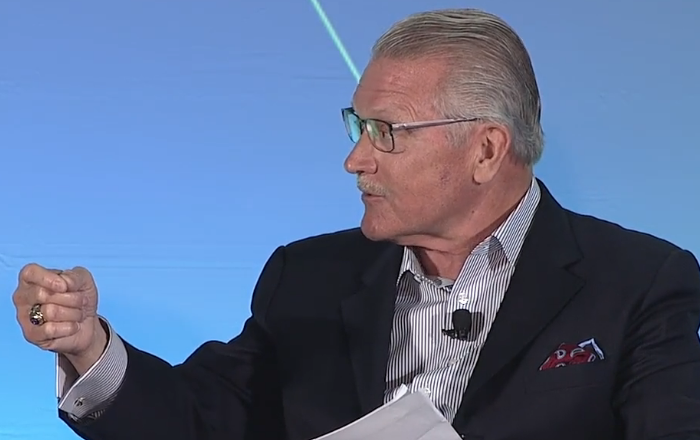The U.S. healthcare industry faces stormy seas. The public and major purchasers are clamoring for cheaper, better care. Sky-high prices for health insurance and some pharmaceuticals are jeopardizing the health and even the lives of patients and increasing public demand for more regulation. Providers are starting to be held responsible not just for providing medical care but for making sure patients have a ride to the doctor and access to healthy food. How can the industry plot a course through this storm to a healthy future for everyone?
Private and public sectors must work together to address patients’ lives as a whole, rather than just the small part that they present when they go to the doctor or a hospital, said panelists at the Health Summit 2018 session “Call to Action: Driving Our Industry’s Future.”
“We talk a lot about moving to value and away from fee for service,” said Tony Tersigni, CEO of Ascension, St. Louis, the largest not-for-profit health system in the U.S. with 141 hospitals in 22 states and the District of Columbia. But that change can’t happen “until we have the government help us remove some of the obstacles, whether they’re laws or regulations or policies that were put in place in a fee-for-service era to protect against fraud and abuse that doesn’t apply today.”
In addition to 65,000 employed physicians, Ascension has affiliate relationships with 44,000 independent physicians. “In order for us to move to value, I’ve got to be able to do partnerships in a creative way with these independent physicians,” Tersigni said. “And right now, I’m precluded from that.” For example, federal antitrust or anti-kickback laws may require special waivers to allow health systems to wrap independent physicians into an accountable care organization and share incentive payments with them.
Ascension, which spent $1.9 billion in 2017 taking care of patients in poor communities, is using some of its markets as labs to identify the most effective ways to spend that money. In one inner city neighborhood, the local Ascension hospital has been collaborating with churches and charities to explore ways to break the cycle of poverty for good. “In these settings, only 26 percent of patients’ needs are healthcare needs—the rest is based on these social determinants,” Tersigni said.
As Ascension is discovering, the healthcare system has enough money, but needs to find new ways of allocating it, said panel host Andy Slavitt, who served as acting administrator of the Centers for Medicare and Medicaid Services during the Obama administration and oversaw its shift toward value-based payment models. He pointed out that there could be a five-fold difference in the cost of treating a diabetic patient who has a stable living situation and good health insurance, compared with one who lives in extreme poverty and struggles with mental illness, even if their blood sugar levels are the same. “That means it’s not about science, but about innovating around people’s lives,” he said. Improving someone’s health could mean providing a medical service or making sure they have a warm coat. “We just take a look at the pool that we’re spending and investing in these populations and figure out how to invest it differently and reduce the cost.”
Using hospital dollars to fund a medical transportation service, a food pantry, or even affordable housing may seem expensive, but these investments could yield significant returns by sharply reducing uncompensated emergency room care and averting chronic illnesses. “Building that business case will be essential,” Slavitt said.
Slavitt is currently CEO of the not-for-profit United States of Care, which brings together healthcare stakeholders, including patients, providers, payers, employers, and policymakers, to work toward affordable quality healthcare. In February, the organization launched MedicaidBuyIn.com and the Medicaid Buy-in Playbook, to help states institute a Medicaid-based public health insurance option.
Payers and providers also need to collaborate on addressing social issues, said Karen Ignagni, President and CEO, EmblemHealth, New York, a not-for-profit insurance company that provides healthcare coverage and administrative services to 3.1 million New York residents. And that means that providers must rethink and expand both their mission and their willingness to be measured on results. “I can’t do a value-based deal with a hospital unless it can accept risk, and unless it has an infrastructure that can follow a patient, figure out how to deal with that patient from a personal perspective,” she said.
EmblemHealth is working with a 2017 startup called Cityblock to improve the overall health of its low-income populations in the Crown Heights neighborhood of Brooklyn by providing them with flexible access to many kinds of care, better communication among members of their care team, and a “community health partner” to coordinate their care and help with their social needs. (Slavitt serves on Cityblock’s board.) EmblemHealth members receive these services at no charge. Cityblock’s founding premise is that the $10,000 average cost of a single hospital stay can pay for hundreds of potentially preventive services: hours with a psychiatrist or primary care provider, visits from a community health worker, or even Uber rides to appointments.
“We are so enthusiastic about bringing people into the communities who are not necessarily wearing white coats—people that folks will confide in,” Ignagni said. “That’s where we have to start.”










